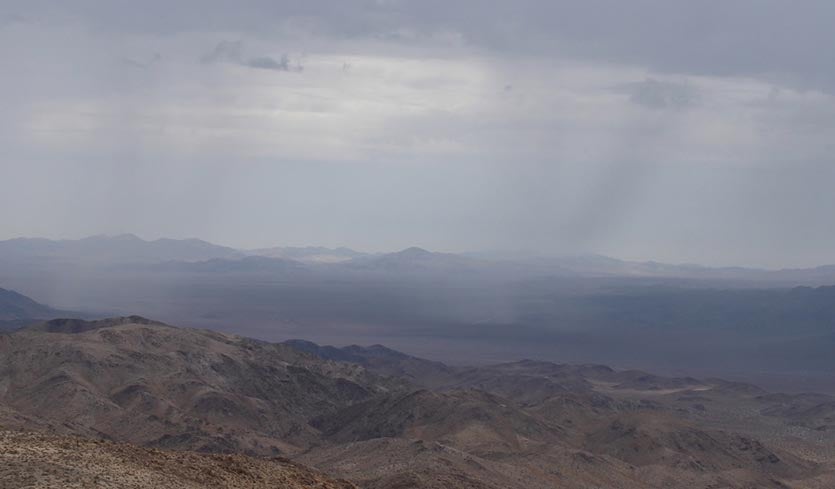Hottest
Rain on Record: Rain Falls at 119°F in Imperial, California
Jeff
McMaster

|
Above: Summer rain showers fall
over the desert region about 40 miles northeast of Imperial,
California, as seen from Belle Mountain in Joshua Tree National
Park, at 12:15 pm PDT July 19, 2017, when the temperature was
100°F (38°C). Image credit: National
Park Service. |
2
August, 2018
Update: Paul
Iniguez of the Phoenix National Weather Service office has done more
detailed analysis on the July 24, 2018 rain event at Imperial,
and has
concluded:
"Did quite a bit of analysis on this. Based on all the data
(radar, satellite, soundings, area obs), this looks like an error
with the present wx sensor.
I really don't think this is a new
record." The present weather sensor is what measures the
presence of rain, when only a trace of rain is reported, and it is
possible for this sensor to get fooled. In particular, there was not
significant cloud cover apparent on satellite
imagery during
the first hour that rain was reported at Imperial, though clouds did
move in after that. In light of Paul's analysis, we have to regard
the world-record hottest rainfall event at Imperial, California as
questionable.
July
24, 2018 was one of the hottest days in California history, as a
searing heat wave of rare intensity, even for the Desert Southwest,
sent temperatures soaring to near-record levels. Death
Valley hit
127°F, just 2° short of tying the all-time world record for hottest
reliably recorded temperature; Palm Springs hit 122°F, just 1°
short of tying its all-time record; and Imperial, California topped
out at 121°F, their hottest day since 124°F was measured on July
28, 1995.
 |
|
Figure
1. Hourly
weather conditions observed in Imperial, California on July 24,
2018, courtesy of NOAA. Rain was observed for four consecutive
hours beginning at 3:53 pm PDT, with a temperature of 119°F
(48.3°C) occurring during the first two hours of the event. A big
thank-you goes to weather records expert Jérôme Reynaud
of Géoclimat for
bringing this event to my attention. |
The
temperature might have gone higher on July 24 in Imperial, but clouds
streaming in from the Gulf of California brought mostly cloudy skies
by mid-afternoon, and rain showers began falling at 3:53 pm PDT. At
the time the rain began, the temperature was an astonishingly high
119°F (48.3°C)—a new world record for the hottest temperature
ever measured while rain was falling. A series of rain showers
continued to affect Imperial in the late afternoon and early evening,
with the station recording light rain for four consecutive hours.
Most of the rain evaporated since the humidity was only 11 - 15%
during the rain event, and only a trace of precipitation was recorded
in the rain gauge. Nevertheless, the July 24 rain at 119°F in
Imperial sets a new record for the hottest rain in world history.
I
called around to some of the businesses and city offices in Imperial
to find someone who could tell me what rain at 119°F felt like, but
most of the people I talked to were too busy hurrying from one air
conditioned place to another at the time to notice the event. One
person did report that going outside after work while the rain was
falling made it difficult to breathe, and felt hard on their heart. I
gave them my sympathy for suffering through this truly rare and
uncomfortable event!
 |
Check out the visible satellite showing storms blowing up over Gila County...and very little further west. #azwx Thanks, @CollegeDuPage for the great weather tools!
Rain is rare at temperatures above 100°F
It
is rare to get rain when the temperature rises above 100°F (38°C),
since heat of that intensity is usually accompanied by a high
pressure system with sinking air, which discourages clouds and
rainfall. In addition, when a shower or thunderstorm does bring rain,
the cold outflow from the approaching cell typically cools the air
before rain starts falling. The July 24, 2018 rain in Imperial was
due to a flow of moisture coming from the southeast caused by the
Southwest U.S. monsoon, a seasonal influx of moisture due to the
difference in temperature between the hot desert and the cooler ocean
areas surrounding Mexico to the south. The air on that day was
flowing from the Gulf of California, where water temperatures were a
bathwater-like 88°F (31°C), about 5°F (3°C) above average.
Evaporation from this hot water provided more moisture than is
usually available to the atmosphere over the Desert Southwest. You
can see a continuous stream of clouds affecting the Imperial region
during the late afternoon and early evening hours of July 24 (lower
left side of the animation from a tweet from NWS Phoenix, embedded
above). These cells were not intense enough to generate a cooling
outflow of air like a thunderstorm would.
The previous
record for the world’s hottest rain occurred
on August 13, 2012, in Needles, California, when rain fell at 115°F
with a humidity of 11%. According to weather records researcher
Maximiliano Herrera, the 11% humidity that accompanied the rain
shower at 115°F in Needles was the lowest humidity at which rain has
ever occurred anywhere on Earth in recorded history. Prior to the
2012 rain event in Needles, the record for hottest rain, which
I blogged
about in June 2012, was
a rain shower at 109°F (43°C) observed in Mecca, Saudi Arabia on
June 5, 2012 and in Marrakech, Morocco on July 10, 2010.
Bob
Henson contributed to this post.

No comments:
Post a Comment
Note: only a member of this blog may post a comment.